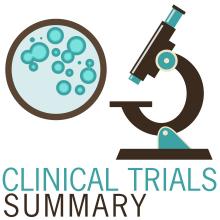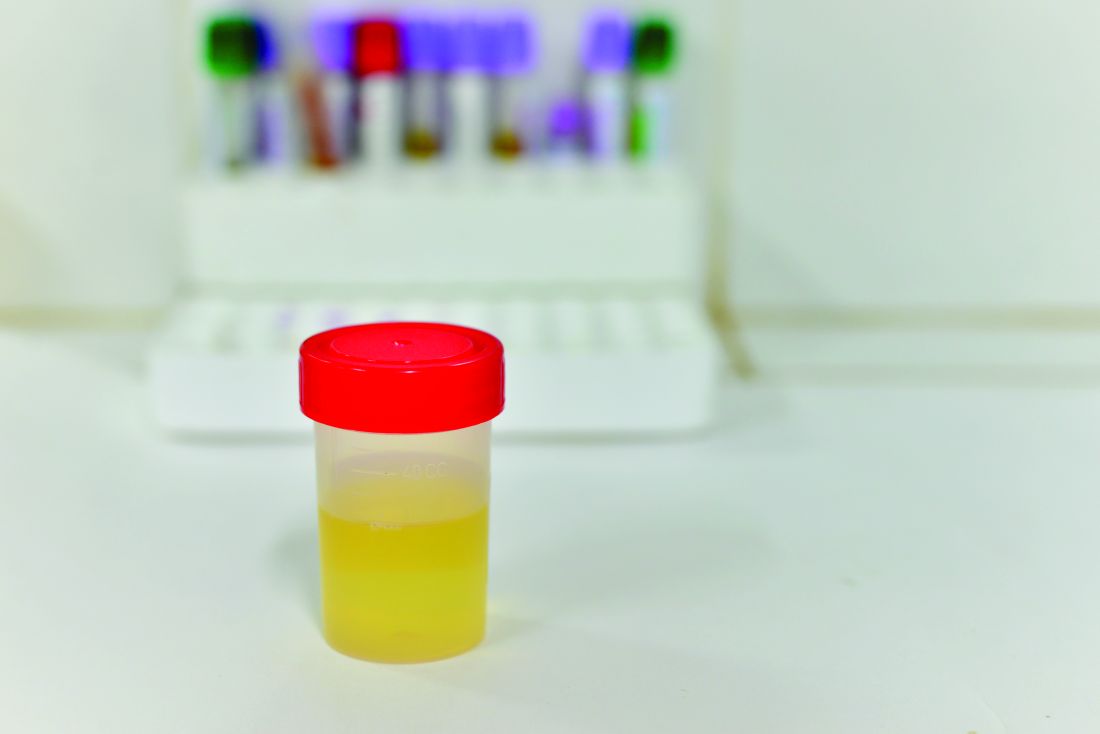User login
Inactivated quadrivalent influenza vaccine safe, effective in 6- to 35-month-olds
MADRID – An intramuscular inactivated quadrivalent influenza vaccine reduced the risk of laboratory-confirmed influenza by up to 69% in previously unvaccinated children aged 6-35 months in a large randomized trial, Stephanie Pepin, MD, reported at the annual meeting of the European Society for Paediatric Infectious Diseases.
The quadrivalent influenza vaccine (QIV) is licensed by the Food and Drug Administration as Fluzone Quadrivalent for use in patients as young as 6 months of age. It contains two A- and two B-lineage influenza strains in order to address the common problem of mismatches between circulating influenza B and the single B-lineage strain included in trivalent vaccines.
The incidence of any laboratory confirmed strain of influenza illness during the period from 14 days post-vaccination to the end of flu season was 4.72% in the QIV group, compared with 9.84% in controls who received placebo, which translated to 52% efficacy. The incidence of influenza from vaccine-similar strains as determined by the Sanger sequencing method was 1.01% in children randomized to QIV, compared with 3.28% with placebo, for a 69% efficacy rate.
The QIV had a safety profile in this young population that was similar to the older licensed trivalent vaccine. The most frequently reported adverse reactions to the QIV were injection site pain, irritability, loss of appetite, abnormal crying, and malaise, each reported in 19%-25% of children after the first injection and in 14%-18% after the second. These were typically mild grade 1 or 2 reactions, which arose in the first 3 days after vaccination and resolved spontaneously 1-3 days later.
The trial was sponsored by Sanofi Pasteur and presented by a company employee.
MADRID – An intramuscular inactivated quadrivalent influenza vaccine reduced the risk of laboratory-confirmed influenza by up to 69% in previously unvaccinated children aged 6-35 months in a large randomized trial, Stephanie Pepin, MD, reported at the annual meeting of the European Society for Paediatric Infectious Diseases.
The quadrivalent influenza vaccine (QIV) is licensed by the Food and Drug Administration as Fluzone Quadrivalent for use in patients as young as 6 months of age. It contains two A- and two B-lineage influenza strains in order to address the common problem of mismatches between circulating influenza B and the single B-lineage strain included in trivalent vaccines.
The incidence of any laboratory confirmed strain of influenza illness during the period from 14 days post-vaccination to the end of flu season was 4.72% in the QIV group, compared with 9.84% in controls who received placebo, which translated to 52% efficacy. The incidence of influenza from vaccine-similar strains as determined by the Sanger sequencing method was 1.01% in children randomized to QIV, compared with 3.28% with placebo, for a 69% efficacy rate.
The QIV had a safety profile in this young population that was similar to the older licensed trivalent vaccine. The most frequently reported adverse reactions to the QIV were injection site pain, irritability, loss of appetite, abnormal crying, and malaise, each reported in 19%-25% of children after the first injection and in 14%-18% after the second. These were typically mild grade 1 or 2 reactions, which arose in the first 3 days after vaccination and resolved spontaneously 1-3 days later.
The trial was sponsored by Sanofi Pasteur and presented by a company employee.
MADRID – An intramuscular inactivated quadrivalent influenza vaccine reduced the risk of laboratory-confirmed influenza by up to 69% in previously unvaccinated children aged 6-35 months in a large randomized trial, Stephanie Pepin, MD, reported at the annual meeting of the European Society for Paediatric Infectious Diseases.
The quadrivalent influenza vaccine (QIV) is licensed by the Food and Drug Administration as Fluzone Quadrivalent for use in patients as young as 6 months of age. It contains two A- and two B-lineage influenza strains in order to address the common problem of mismatches between circulating influenza B and the single B-lineage strain included in trivalent vaccines.
The incidence of any laboratory confirmed strain of influenza illness during the period from 14 days post-vaccination to the end of flu season was 4.72% in the QIV group, compared with 9.84% in controls who received placebo, which translated to 52% efficacy. The incidence of influenza from vaccine-similar strains as determined by the Sanger sequencing method was 1.01% in children randomized to QIV, compared with 3.28% with placebo, for a 69% efficacy rate.
The QIV had a safety profile in this young population that was similar to the older licensed trivalent vaccine. The most frequently reported adverse reactions to the QIV were injection site pain, irritability, loss of appetite, abnormal crying, and malaise, each reported in 19%-25% of children after the first injection and in 14%-18% after the second. These were typically mild grade 1 or 2 reactions, which arose in the first 3 days after vaccination and resolved spontaneously 1-3 days later.
The trial was sponsored by Sanofi Pasteur and presented by a company employee.
AT ESPID 2017
Key clinical point:
Major finding: The intramuscular inactivated influenza vaccine, Fluzone Quadrivalent, reduced the risk of laboratory-confirmed influenza by up to 69% in 6- to 35-month-olds.
Data source: This randomized, multinational, placebo-controlled trial included 5,806 healthy 6- to 35-month-old children.
Disclosures: The study was sponsored by Sanofi Pasteur and presented by a company employee.
Beating your wandering attention
Like many adults, I suspect that I may have been living under the cloud of an undiagnosed case of attention-deficit/hyperactivity disorder (ADHD). What else could explain why my mind wanders during the second hole of my wife’s narrative of her morning golf outing with her friends? Why have I never been in a class or lecture in which after 20 minutes I began wishing I were somewhere else? In my student days, I felt compelled to leave my studies and go to the refrigerator every 15 minutes – even though I wasn’t hungry. Sounds like ADHD to me.
But I know what you are thinking. This guy graduated from medical school, and has been married to the same woman for nearly 50 years. He has no criminal record and has held the same job for more than 40 years. I will admit that my life trajectory is atypical for someone even with a mild case of adult ADHD.
Actually, I don’t really believe that I have an undiagnosed case of ADHD. But I do feel that my attention span is at the short end of the normal spectrum. And I think that by good fortune I stumbled on several strategies that helped me thrive in an academic environment despite my relative attention deficit.
Most noteworthy among those strategies was my habit of listening to heavy metal music with a throbbing beat while I was studying. At my recent college reunion, former classmates whom I hadn’t seen in 50 years reminded me of how often I drove them to quieter study oases with the driving rhythms of the Rolling Stones’ misogynistic anthem “Under My Thumb.”My wife still recalls her amazement the first (and last) time she offered to keep me company while I studied for a pathophysiology exam. She found me hunched over my notes spread out on a coffee table, my knees bouncing to the beat of Joe Cocker crowing the Beatles’ classic “She Came in Through the Bathroom Window” (still one of my all-time favorites). Earbuds hadn’t been invented, and I considered earphones the size of chili bowls too dorky.
I always have assumed that my study habits were just a little weird. But recently I discovered an article describing the work of Alexander Pantelyat, MD, assistant professor of neurology and cofounder of the Johns Hopkins Center for Music and Medicine (“Does Listening to Music Improve Your Focus?” by Heidi Mitchell, Wall Street Journal, July 26, 2017). Dr. Pantelyat notes that the early enthusiasm for playing Mozart to newborns has faded with the understanding that any improvement in learning skills was short-lived. However, he sees some evidence that hearing music of a genre you enjoy may help you focus better than listening to music that you don’t like. He says, “If you enjoy heavy metal, you might be more focused when you listen to it.”
As Dr. Pantelyat cautions, the response to music is highly individual. I generally have not recommended my peculiar study habits to my patients. However, my experience has left me more open-minded when trying to help young people struggling to find a study strategy that works. You may not share my affinity for the Rolling Stones and Joe Cocker, but you have to admit you would rather have your patients listen to their music than take drugs they may not need.
Like many adults, I suspect that I may have been living under the cloud of an undiagnosed case of attention-deficit/hyperactivity disorder (ADHD). What else could explain why my mind wanders during the second hole of my wife’s narrative of her morning golf outing with her friends? Why have I never been in a class or lecture in which after 20 minutes I began wishing I were somewhere else? In my student days, I felt compelled to leave my studies and go to the refrigerator every 15 minutes – even though I wasn’t hungry. Sounds like ADHD to me.
But I know what you are thinking. This guy graduated from medical school, and has been married to the same woman for nearly 50 years. He has no criminal record and has held the same job for more than 40 years. I will admit that my life trajectory is atypical for someone even with a mild case of adult ADHD.
Actually, I don’t really believe that I have an undiagnosed case of ADHD. But I do feel that my attention span is at the short end of the normal spectrum. And I think that by good fortune I stumbled on several strategies that helped me thrive in an academic environment despite my relative attention deficit.
Most noteworthy among those strategies was my habit of listening to heavy metal music with a throbbing beat while I was studying. At my recent college reunion, former classmates whom I hadn’t seen in 50 years reminded me of how often I drove them to quieter study oases with the driving rhythms of the Rolling Stones’ misogynistic anthem “Under My Thumb.”My wife still recalls her amazement the first (and last) time she offered to keep me company while I studied for a pathophysiology exam. She found me hunched over my notes spread out on a coffee table, my knees bouncing to the beat of Joe Cocker crowing the Beatles’ classic “She Came in Through the Bathroom Window” (still one of my all-time favorites). Earbuds hadn’t been invented, and I considered earphones the size of chili bowls too dorky.
I always have assumed that my study habits were just a little weird. But recently I discovered an article describing the work of Alexander Pantelyat, MD, assistant professor of neurology and cofounder of the Johns Hopkins Center for Music and Medicine (“Does Listening to Music Improve Your Focus?” by Heidi Mitchell, Wall Street Journal, July 26, 2017). Dr. Pantelyat notes that the early enthusiasm for playing Mozart to newborns has faded with the understanding that any improvement in learning skills was short-lived. However, he sees some evidence that hearing music of a genre you enjoy may help you focus better than listening to music that you don’t like. He says, “If you enjoy heavy metal, you might be more focused when you listen to it.”
As Dr. Pantelyat cautions, the response to music is highly individual. I generally have not recommended my peculiar study habits to my patients. However, my experience has left me more open-minded when trying to help young people struggling to find a study strategy that works. You may not share my affinity for the Rolling Stones and Joe Cocker, but you have to admit you would rather have your patients listen to their music than take drugs they may not need.
Like many adults, I suspect that I may have been living under the cloud of an undiagnosed case of attention-deficit/hyperactivity disorder (ADHD). What else could explain why my mind wanders during the second hole of my wife’s narrative of her morning golf outing with her friends? Why have I never been in a class or lecture in which after 20 minutes I began wishing I were somewhere else? In my student days, I felt compelled to leave my studies and go to the refrigerator every 15 minutes – even though I wasn’t hungry. Sounds like ADHD to me.
But I know what you are thinking. This guy graduated from medical school, and has been married to the same woman for nearly 50 years. He has no criminal record and has held the same job for more than 40 years. I will admit that my life trajectory is atypical for someone even with a mild case of adult ADHD.
Actually, I don’t really believe that I have an undiagnosed case of ADHD. But I do feel that my attention span is at the short end of the normal spectrum. And I think that by good fortune I stumbled on several strategies that helped me thrive in an academic environment despite my relative attention deficit.
Most noteworthy among those strategies was my habit of listening to heavy metal music with a throbbing beat while I was studying. At my recent college reunion, former classmates whom I hadn’t seen in 50 years reminded me of how often I drove them to quieter study oases with the driving rhythms of the Rolling Stones’ misogynistic anthem “Under My Thumb.”My wife still recalls her amazement the first (and last) time she offered to keep me company while I studied for a pathophysiology exam. She found me hunched over my notes spread out on a coffee table, my knees bouncing to the beat of Joe Cocker crowing the Beatles’ classic “She Came in Through the Bathroom Window” (still one of my all-time favorites). Earbuds hadn’t been invented, and I considered earphones the size of chili bowls too dorky.
I always have assumed that my study habits were just a little weird. But recently I discovered an article describing the work of Alexander Pantelyat, MD, assistant professor of neurology and cofounder of the Johns Hopkins Center for Music and Medicine (“Does Listening to Music Improve Your Focus?” by Heidi Mitchell, Wall Street Journal, July 26, 2017). Dr. Pantelyat notes that the early enthusiasm for playing Mozart to newborns has faded with the understanding that any improvement in learning skills was short-lived. However, he sees some evidence that hearing music of a genre you enjoy may help you focus better than listening to music that you don’t like. He says, “If you enjoy heavy metal, you might be more focused when you listen to it.”
As Dr. Pantelyat cautions, the response to music is highly individual. I generally have not recommended my peculiar study habits to my patients. However, my experience has left me more open-minded when trying to help young people struggling to find a study strategy that works. You may not share my affinity for the Rolling Stones and Joe Cocker, but you have to admit you would rather have your patients listen to their music than take drugs they may not need.
Analysis: Gabapentinoids aren’t the answer to back pain
Treating chronic lower back pain with gabapentinoids carries risks of dizziness, fatigue, and other side effects, but there is little evidence of their efficacy, according to a meta-analysis.
First-line analgesic treatment of chronic lower back pain (CLBP) often brings insufficient relief, leading to second-line treatments with gabapentinoids such as gabapentin (GB) or pregabalin (PG). These drugs are effective for neuropathic pain, but in most cases, CLBP has no clear cause.
Long-term use of gabapentinoids for CLBP has been increasing, but it could carry the risk of side effects. That prompted Harsha Shanthanna, MD, of McMaster University, Hamilton, Ont., and his colleagues to analyze existing research to determine their efficacy and potential harms in the treatment of CLBP.
The authors converted pain relief expressed in numerical rating scale or visual analog scale into a common scale of pain relief.
A meta-analysis of trials that compared GB to placebo found a small reduction in pain in the GB group (mean difference, 0.22 units; 95% confidence interval [CI], –0.51-0.07). No studies compared PG to placebo. Three studies (n = 169) compared PG to an active comparator, and the comparator yielded better improvements in pain (mean difference, 0.42 units; 95% CI, 0.20-0.64). The quality of evidence was rated very low in both PG to comparator and GB to placebo.
No deaths or hospitalizations were reported in the studies. Rates of adverse events were higher in the gabapentinoid groups than in the placebo group, including dizziness (risk ratio, 1.99, 95% CI, 1.17-3.37; number needed to harm, 7), fatigue (RR, 1.85; 95% CI, 1.12-3.05; I2 = 0; NNH, 8), difficulties with mentation (RR, 3.34; 95% CI, 1.54-7.25; NNH, 6), and visual disturbances (RR, 5.72; 95% CI, 1.94-16.91; NNH, 6). The evidence was of very low quality for dizziness and fatigue, low for difficulties with mentation, and moderate with respect to visual disturbances.
Dizziness was more common in PG groups, compared with active comparators (RR, 2.70; 95% CI, 1.25-5.83; NNH, 11), although the quality of evidence was very low.
The study included only a small number of trials, which could lead to issues with heterogeneity, the investigators cautioned.
“Our review demonstrates that there is limited evidence on the use of gabapentinoids in nonspecific CLBP, and the existing evidence in the form of RCTs does not support their use,” the authors concluded.
The study was not funded, and the authors reported having no relevant financial disclosures.
Treating chronic lower back pain with gabapentinoids carries risks of dizziness, fatigue, and other side effects, but there is little evidence of their efficacy, according to a meta-analysis.
First-line analgesic treatment of chronic lower back pain (CLBP) often brings insufficient relief, leading to second-line treatments with gabapentinoids such as gabapentin (GB) or pregabalin (PG). These drugs are effective for neuropathic pain, but in most cases, CLBP has no clear cause.
Long-term use of gabapentinoids for CLBP has been increasing, but it could carry the risk of side effects. That prompted Harsha Shanthanna, MD, of McMaster University, Hamilton, Ont., and his colleagues to analyze existing research to determine their efficacy and potential harms in the treatment of CLBP.
The authors converted pain relief expressed in numerical rating scale or visual analog scale into a common scale of pain relief.
A meta-analysis of trials that compared GB to placebo found a small reduction in pain in the GB group (mean difference, 0.22 units; 95% confidence interval [CI], –0.51-0.07). No studies compared PG to placebo. Three studies (n = 169) compared PG to an active comparator, and the comparator yielded better improvements in pain (mean difference, 0.42 units; 95% CI, 0.20-0.64). The quality of evidence was rated very low in both PG to comparator and GB to placebo.
No deaths or hospitalizations were reported in the studies. Rates of adverse events were higher in the gabapentinoid groups than in the placebo group, including dizziness (risk ratio, 1.99, 95% CI, 1.17-3.37; number needed to harm, 7), fatigue (RR, 1.85; 95% CI, 1.12-3.05; I2 = 0; NNH, 8), difficulties with mentation (RR, 3.34; 95% CI, 1.54-7.25; NNH, 6), and visual disturbances (RR, 5.72; 95% CI, 1.94-16.91; NNH, 6). The evidence was of very low quality for dizziness and fatigue, low for difficulties with mentation, and moderate with respect to visual disturbances.
Dizziness was more common in PG groups, compared with active comparators (RR, 2.70; 95% CI, 1.25-5.83; NNH, 11), although the quality of evidence was very low.
The study included only a small number of trials, which could lead to issues with heterogeneity, the investigators cautioned.
“Our review demonstrates that there is limited evidence on the use of gabapentinoids in nonspecific CLBP, and the existing evidence in the form of RCTs does not support their use,” the authors concluded.
The study was not funded, and the authors reported having no relevant financial disclosures.
Treating chronic lower back pain with gabapentinoids carries risks of dizziness, fatigue, and other side effects, but there is little evidence of their efficacy, according to a meta-analysis.
First-line analgesic treatment of chronic lower back pain (CLBP) often brings insufficient relief, leading to second-line treatments with gabapentinoids such as gabapentin (GB) or pregabalin (PG). These drugs are effective for neuropathic pain, but in most cases, CLBP has no clear cause.
Long-term use of gabapentinoids for CLBP has been increasing, but it could carry the risk of side effects. That prompted Harsha Shanthanna, MD, of McMaster University, Hamilton, Ont., and his colleagues to analyze existing research to determine their efficacy and potential harms in the treatment of CLBP.
The authors converted pain relief expressed in numerical rating scale or visual analog scale into a common scale of pain relief.
A meta-analysis of trials that compared GB to placebo found a small reduction in pain in the GB group (mean difference, 0.22 units; 95% confidence interval [CI], –0.51-0.07). No studies compared PG to placebo. Three studies (n = 169) compared PG to an active comparator, and the comparator yielded better improvements in pain (mean difference, 0.42 units; 95% CI, 0.20-0.64). The quality of evidence was rated very low in both PG to comparator and GB to placebo.
No deaths or hospitalizations were reported in the studies. Rates of adverse events were higher in the gabapentinoid groups than in the placebo group, including dizziness (risk ratio, 1.99, 95% CI, 1.17-3.37; number needed to harm, 7), fatigue (RR, 1.85; 95% CI, 1.12-3.05; I2 = 0; NNH, 8), difficulties with mentation (RR, 3.34; 95% CI, 1.54-7.25; NNH, 6), and visual disturbances (RR, 5.72; 95% CI, 1.94-16.91; NNH, 6). The evidence was of very low quality for dizziness and fatigue, low for difficulties with mentation, and moderate with respect to visual disturbances.
Dizziness was more common in PG groups, compared with active comparators (RR, 2.70; 95% CI, 1.25-5.83; NNH, 11), although the quality of evidence was very low.
The study included only a small number of trials, which could lead to issues with heterogeneity, the investigators cautioned.
“Our review demonstrates that there is limited evidence on the use of gabapentinoids in nonspecific CLBP, and the existing evidence in the form of RCTs does not support their use,” the authors concluded.
The study was not funded, and the authors reported having no relevant financial disclosures.
FROM PLOS MEDICINE
Key clinical point: Gabapentins were little better than placebo for chronic lower back pain, but they posed risks of dizziness and other effects.
Major finding: A meta-analysis of trials that compared gabapentin to placebo found a small reduction in pain in the gabapentin group, but rates of adverse events were higher in the gabapentinoid groups.
Data source: A meta-analysis of 14 randomized, controlled trials.
Disclosures: The study was not funded, and the authors reported having no relevant financial disclosures.
Vitamin D level linked to post-alloSCT relapse risk in myeloma
Patients with myeloid malignancies who have vitamin D deficiency prior to an allogeneic stem cell transplant (alloSCT) are significantly more likely to experience a relapse and have worse overall survival after transplant than patients with adequate vitamin D levels at baseline, investigators have found.
Among 492 patients with lymphoid or myeloid malignancies who had an alloSCT at a single center, those with vitamin D deficiency had a risk of post-transplant relapse that was nearly double the risk of patients with sufficient vitamin D levels. Also, this relapse risk contributed to significantly worse overall survival for the vitamin D–deficient patients, reported Thomas Luft, MD, PhD, and his colleagues from the University of Heidelberg, Germany.
In multivariate analysis, the risk for relapse was limited to patients with myeloid rather than lymphatic disease, they reported in the Journal of Clinical Oncology.
“[O]ur study suggests that VitD deficiency might affect disease control after alloSCT, in particular, in patients allografted for myeloid malignancies. However, the question of whether improving VitD status before alloSCT has an impact on outcome can only be answered by clinical trial,” they wrote.
To see whether pre-transplant vitamin D deficiency – serum levels of 25-hydroxyvitamin D3 less than 20 ng/mL – might have prognostic significance, the investigators looked at a training cohort of 492 patients who underwent alloSCT at their center from 2002 through 2013, and a validation cohort consisting of 398 additional patients with myeloid malignancies treated at the University of Essen, Germany.
Overall survival for the 396 patients (80%) in the training cohort with vitamin D deficiency was significantly worse than for patients with adequate levels (hazard ratio, 1.78; P = .007) in a multivariate analysis adjusted for type of malignancy, disease stage, conditioning intensity, patient age, donor type, and recipient/donor sex match.
Analysis also showed that the excess hazard was accounted for by higher risk of relapse than nonrelapse mortality (HR, 1.96; P = .006).
When the investigators looked at relapse risk by disease type, they found a significantly higher risk among vitamin D–deficient patients with myeloid malignancies (HR, 2.55; P = .014) but not with lymphoid malignancies.
The risk for relapse among patients with myeloid malignancies in the validation cohort was similarly high (HR, 2.60; P = .017).
“The growth inhibitory, pro-differentiation, and pro-apoptotic effects of VitD in vitro are well recognized, and low VitD levels have been shown to enhance clonal proliferation of leukemic cells. Therefore, with regard to treatment before alloSCT but also to conditioning, one might speculate that VitD deficiency facilitates resistance to chemotherapy,” the researchers wrote.
Low vitamin D levels have been associated in other studies with shorter relapse-free and overall survival in patients with acute myeloid leukemia apart from alloSCT.
The researchers recommend clinical trials to explore the possibility that vitamin D supplementation pre-transplant could improve post-transplant outcomes.
The study was supported by a grant from the BLUT Foundation and the European Union’s Seventh Framework Program. Dr. Luft disclosed consulting with Alexion and Jazz Pharmaceuticals, and institutional research funding and travel support from Medac, Neovii, and Jazz.
Patients with myeloid malignancies who have vitamin D deficiency prior to an allogeneic stem cell transplant (alloSCT) are significantly more likely to experience a relapse and have worse overall survival after transplant than patients with adequate vitamin D levels at baseline, investigators have found.
Among 492 patients with lymphoid or myeloid malignancies who had an alloSCT at a single center, those with vitamin D deficiency had a risk of post-transplant relapse that was nearly double the risk of patients with sufficient vitamin D levels. Also, this relapse risk contributed to significantly worse overall survival for the vitamin D–deficient patients, reported Thomas Luft, MD, PhD, and his colleagues from the University of Heidelberg, Germany.
In multivariate analysis, the risk for relapse was limited to patients with myeloid rather than lymphatic disease, they reported in the Journal of Clinical Oncology.
“[O]ur study suggests that VitD deficiency might affect disease control after alloSCT, in particular, in patients allografted for myeloid malignancies. However, the question of whether improving VitD status before alloSCT has an impact on outcome can only be answered by clinical trial,” they wrote.
To see whether pre-transplant vitamin D deficiency – serum levels of 25-hydroxyvitamin D3 less than 20 ng/mL – might have prognostic significance, the investigators looked at a training cohort of 492 patients who underwent alloSCT at their center from 2002 through 2013, and a validation cohort consisting of 398 additional patients with myeloid malignancies treated at the University of Essen, Germany.
Overall survival for the 396 patients (80%) in the training cohort with vitamin D deficiency was significantly worse than for patients with adequate levels (hazard ratio, 1.78; P = .007) in a multivariate analysis adjusted for type of malignancy, disease stage, conditioning intensity, patient age, donor type, and recipient/donor sex match.
Analysis also showed that the excess hazard was accounted for by higher risk of relapse than nonrelapse mortality (HR, 1.96; P = .006).
When the investigators looked at relapse risk by disease type, they found a significantly higher risk among vitamin D–deficient patients with myeloid malignancies (HR, 2.55; P = .014) but not with lymphoid malignancies.
The risk for relapse among patients with myeloid malignancies in the validation cohort was similarly high (HR, 2.60; P = .017).
“The growth inhibitory, pro-differentiation, and pro-apoptotic effects of VitD in vitro are well recognized, and low VitD levels have been shown to enhance clonal proliferation of leukemic cells. Therefore, with regard to treatment before alloSCT but also to conditioning, one might speculate that VitD deficiency facilitates resistance to chemotherapy,” the researchers wrote.
Low vitamin D levels have been associated in other studies with shorter relapse-free and overall survival in patients with acute myeloid leukemia apart from alloSCT.
The researchers recommend clinical trials to explore the possibility that vitamin D supplementation pre-transplant could improve post-transplant outcomes.
The study was supported by a grant from the BLUT Foundation and the European Union’s Seventh Framework Program. Dr. Luft disclosed consulting with Alexion and Jazz Pharmaceuticals, and institutional research funding and travel support from Medac, Neovii, and Jazz.
Patients with myeloid malignancies who have vitamin D deficiency prior to an allogeneic stem cell transplant (alloSCT) are significantly more likely to experience a relapse and have worse overall survival after transplant than patients with adequate vitamin D levels at baseline, investigators have found.
Among 492 patients with lymphoid or myeloid malignancies who had an alloSCT at a single center, those with vitamin D deficiency had a risk of post-transplant relapse that was nearly double the risk of patients with sufficient vitamin D levels. Also, this relapse risk contributed to significantly worse overall survival for the vitamin D–deficient patients, reported Thomas Luft, MD, PhD, and his colleagues from the University of Heidelberg, Germany.
In multivariate analysis, the risk for relapse was limited to patients with myeloid rather than lymphatic disease, they reported in the Journal of Clinical Oncology.
“[O]ur study suggests that VitD deficiency might affect disease control after alloSCT, in particular, in patients allografted for myeloid malignancies. However, the question of whether improving VitD status before alloSCT has an impact on outcome can only be answered by clinical trial,” they wrote.
To see whether pre-transplant vitamin D deficiency – serum levels of 25-hydroxyvitamin D3 less than 20 ng/mL – might have prognostic significance, the investigators looked at a training cohort of 492 patients who underwent alloSCT at their center from 2002 through 2013, and a validation cohort consisting of 398 additional patients with myeloid malignancies treated at the University of Essen, Germany.
Overall survival for the 396 patients (80%) in the training cohort with vitamin D deficiency was significantly worse than for patients with adequate levels (hazard ratio, 1.78; P = .007) in a multivariate analysis adjusted for type of malignancy, disease stage, conditioning intensity, patient age, donor type, and recipient/donor sex match.
Analysis also showed that the excess hazard was accounted for by higher risk of relapse than nonrelapse mortality (HR, 1.96; P = .006).
When the investigators looked at relapse risk by disease type, they found a significantly higher risk among vitamin D–deficient patients with myeloid malignancies (HR, 2.55; P = .014) but not with lymphoid malignancies.
The risk for relapse among patients with myeloid malignancies in the validation cohort was similarly high (HR, 2.60; P = .017).
“The growth inhibitory, pro-differentiation, and pro-apoptotic effects of VitD in vitro are well recognized, and low VitD levels have been shown to enhance clonal proliferation of leukemic cells. Therefore, with regard to treatment before alloSCT but also to conditioning, one might speculate that VitD deficiency facilitates resistance to chemotherapy,” the researchers wrote.
Low vitamin D levels have been associated in other studies with shorter relapse-free and overall survival in patients with acute myeloid leukemia apart from alloSCT.
The researchers recommend clinical trials to explore the possibility that vitamin D supplementation pre-transplant could improve post-transplant outcomes.
The study was supported by a grant from the BLUT Foundation and the European Union’s Seventh Framework Program. Dr. Luft disclosed consulting with Alexion and Jazz Pharmaceuticals, and institutional research funding and travel support from Medac, Neovii, and Jazz.
FROM JCO
Key clinical point: Vitamin D deficiency pre–allogenic stem cell transplant was associated with greater risk of relapse and lower survival for patients with myeloid malignancies.
Major finding: The hazard for relapse among patients with myeloid malignancies and low pre-transplant vitamin D was 2.55 (P = .014), compared with patients with adequate vitamin D.
Data source: Retrospective cohort study of 492 patients with myeloid or lymphoid malignancies, and a validation cohort of 398 patients.
Disclosures: The study was supported by a grant from the BLUT Foundation and the European Union’s Seventh Framework Program. Dr. Luft disclosed consulting with Alexion and Jazz Pharmaceuticals, and institutional research funding and travel support from Medac, Neovii, and Jazz.
Clinical trial: Use of robotics for cholecystectomy
The Use of Robotics for Cholecystectomy study is a retrospective review currently recruiting patients who underwent robotic-assisted laparoscopic cholecystectomy from June 2004 through May 2015.
Several methods are considered standard of care for the surgical treatment of cholecystitis, including open surgery, laparoscopic, and robotic-assisted laparoscopic surgery. This study, a retrospective analysis of charts, operating room notes, and operating room documentation of procedures, will review intraoperative and postoperative clinical outcomes of robotic-assisted laparoscopic cholecystectomy.
The intent of the study is to establish the role of robotics in laparoscopic surgery and to assess the learning curve for surgeons. Primary outcomes will be to compare hernia rates between multiport and single-port approaches, and to compare multiport against single-port approaches through the standard of care model of normal postsurgery follow-ups, along with additional follow-ups if complications are seen.
Recruitment for the study ends in May 2019. About 500 people are expected to be included in the final analysis.
Find more information at the study page on Clinicaltrials.gov.
The Use of Robotics for Cholecystectomy study is a retrospective review currently recruiting patients who underwent robotic-assisted laparoscopic cholecystectomy from June 2004 through May 2015.
Several methods are considered standard of care for the surgical treatment of cholecystitis, including open surgery, laparoscopic, and robotic-assisted laparoscopic surgery. This study, a retrospective analysis of charts, operating room notes, and operating room documentation of procedures, will review intraoperative and postoperative clinical outcomes of robotic-assisted laparoscopic cholecystectomy.
The intent of the study is to establish the role of robotics in laparoscopic surgery and to assess the learning curve for surgeons. Primary outcomes will be to compare hernia rates between multiport and single-port approaches, and to compare multiport against single-port approaches through the standard of care model of normal postsurgery follow-ups, along with additional follow-ups if complications are seen.
Recruitment for the study ends in May 2019. About 500 people are expected to be included in the final analysis.
Find more information at the study page on Clinicaltrials.gov.
The Use of Robotics for Cholecystectomy study is a retrospective review currently recruiting patients who underwent robotic-assisted laparoscopic cholecystectomy from June 2004 through May 2015.
Several methods are considered standard of care for the surgical treatment of cholecystitis, including open surgery, laparoscopic, and robotic-assisted laparoscopic surgery. This study, a retrospective analysis of charts, operating room notes, and operating room documentation of procedures, will review intraoperative and postoperative clinical outcomes of robotic-assisted laparoscopic cholecystectomy.
The intent of the study is to establish the role of robotics in laparoscopic surgery and to assess the learning curve for surgeons. Primary outcomes will be to compare hernia rates between multiport and single-port approaches, and to compare multiport against single-port approaches through the standard of care model of normal postsurgery follow-ups, along with additional follow-ups if complications are seen.
Recruitment for the study ends in May 2019. About 500 people are expected to be included in the final analysis.
Find more information at the study page on Clinicaltrials.gov.
SUMMARY FROM CLINICALTRIALS.GOV
Paying it forward
I was 14 when my grandmother fell and broke her hip. She went to the emergency department by ambulance from the restaurant we were at, and Dad took me to the hospital with him. He was an only child, and not a medical person. He was very worried.
There, Grandma looked older and more frail than usual. She and my dad were both anxious when told she’d need surgery.
Then the orthopedic surgeon came in. Tall and confident, he was initially quite imposing. But he was polite and had a great bedside manner. He calmed my dad and grandmother down, explained what needed to be done, and was reassuring. After surgery, he came to the waiting room to let us know things had gone well. I remember how impressed Dad and I both were.
Now, here was that surgeon again, on the other side of my desk. Arthritis had taken away some of his height. But he still carried himself with a proud dignity.
His family had brought him to me for worsening memory problems. He thought he was still in practice, although he had retired years ago. He didn’t remember his address, what city we were in, or what a clock looked like.
You hear families talk about how much Alzheimer’s disease takes away from a loved one, but you rarely have the opportunity in a practice to see for yourself. But the impression he’d made on me over 35 years ago was still strong, and I remembered every detail in comparison to the person across from me today.
In his field, he fixed things. With screws, rods, and casts he could restore broken bones, returning them to strength and use – like he had with my grandmother.
Sadly, I can’t return the favor now. I can only offer his family comfort, and answer questions, the way he once did with mine.
I started donepezil and gave them the most optimistic talk I have for these cases. But I know we’re still far away from fixing broken brains.
After he left, I found myself looking in the mirror, thinking of how I saw him then, wondering if his family saw me the same way now, and realizing that someday my children and I may be in the same situation.
Dr. Block has a solo neurology practice in Scottsdale, Ariz.
I was 14 when my grandmother fell and broke her hip. She went to the emergency department by ambulance from the restaurant we were at, and Dad took me to the hospital with him. He was an only child, and not a medical person. He was very worried.
There, Grandma looked older and more frail than usual. She and my dad were both anxious when told she’d need surgery.
Then the orthopedic surgeon came in. Tall and confident, he was initially quite imposing. But he was polite and had a great bedside manner. He calmed my dad and grandmother down, explained what needed to be done, and was reassuring. After surgery, he came to the waiting room to let us know things had gone well. I remember how impressed Dad and I both were.
Now, here was that surgeon again, on the other side of my desk. Arthritis had taken away some of his height. But he still carried himself with a proud dignity.
His family had brought him to me for worsening memory problems. He thought he was still in practice, although he had retired years ago. He didn’t remember his address, what city we were in, or what a clock looked like.
You hear families talk about how much Alzheimer’s disease takes away from a loved one, but you rarely have the opportunity in a practice to see for yourself. But the impression he’d made on me over 35 years ago was still strong, and I remembered every detail in comparison to the person across from me today.
In his field, he fixed things. With screws, rods, and casts he could restore broken bones, returning them to strength and use – like he had with my grandmother.
Sadly, I can’t return the favor now. I can only offer his family comfort, and answer questions, the way he once did with mine.
I started donepezil and gave them the most optimistic talk I have for these cases. But I know we’re still far away from fixing broken brains.
After he left, I found myself looking in the mirror, thinking of how I saw him then, wondering if his family saw me the same way now, and realizing that someday my children and I may be in the same situation.
Dr. Block has a solo neurology practice in Scottsdale, Ariz.
I was 14 when my grandmother fell and broke her hip. She went to the emergency department by ambulance from the restaurant we were at, and Dad took me to the hospital with him. He was an only child, and not a medical person. He was very worried.
There, Grandma looked older and more frail than usual. She and my dad were both anxious when told she’d need surgery.
Then the orthopedic surgeon came in. Tall and confident, he was initially quite imposing. But he was polite and had a great bedside manner. He calmed my dad and grandmother down, explained what needed to be done, and was reassuring. After surgery, he came to the waiting room to let us know things had gone well. I remember how impressed Dad and I both were.
Now, here was that surgeon again, on the other side of my desk. Arthritis had taken away some of his height. But he still carried himself with a proud dignity.
His family had brought him to me for worsening memory problems. He thought he was still in practice, although he had retired years ago. He didn’t remember his address, what city we were in, or what a clock looked like.
You hear families talk about how much Alzheimer’s disease takes away from a loved one, but you rarely have the opportunity in a practice to see for yourself. But the impression he’d made on me over 35 years ago was still strong, and I remembered every detail in comparison to the person across from me today.
In his field, he fixed things. With screws, rods, and casts he could restore broken bones, returning them to strength and use – like he had with my grandmother.
Sadly, I can’t return the favor now. I can only offer his family comfort, and answer questions, the way he once did with mine.
I started donepezil and gave them the most optimistic talk I have for these cases. But I know we’re still far away from fixing broken brains.
After he left, I found myself looking in the mirror, thinking of how I saw him then, wondering if his family saw me the same way now, and realizing that someday my children and I may be in the same situation.
Dr. Block has a solo neurology practice in Scottsdale, Ariz.
Researchers develop 30-min antibiotic susceptibility test for UTI
Researchers in Sweden have developed a 30-minute test capable of determining whether a bacterial urinary tract infection is susceptible or resistant to nine antibiotics. Their findings suggest that it is possible to develop a point-of-care test for patients with UTI.
Most phenotypic and genotypic antibiotic susceptibility tests are too slow to guide treatment, ranging from 2 days to 1 hour. The researchers at Uppsala (Sweden) University cut the testing time down to less than 30 minutes by using a microfluidic chip and direct single-cell imaging.
The chip traps the bacterial cells and allows growth media with different antibiotics (or none) to flow around them. “With this setup, we could detect the differential growth rate between treatment and reference populations in 3 min for ciprofloxacin, levofloxacin, mecillinam, nitrofurantoin, and trimethoprim-sulfamethoxazole; 7 min for amoxicillin-clavulanate and doripenem; 9 min for fosfomycin; and 11 min for ampicillin based on 99.9% confidence intervals,” wrote Özden Baltekin and his coauthors.
That test specifically used Escherichia coli cells; comparable speed and accuracy was replicated using Klebsiella pneumoniae and Staphylococcus saprophyticus. For the development of a point-of-care test for patients, the researchers said all that would be needed are about 100 bacteria cells.
“We have here focused on bacterial species and antibiotics related to UTIs, but it is likely that the same principles would work for sepsis, mastitis, or meningitis,” they suggested (Proc Natl Acad Sci. 2017 Aug 8. doi: 10.1073/pnas.1708558114).
Researchers in Sweden have developed a 30-minute test capable of determining whether a bacterial urinary tract infection is susceptible or resistant to nine antibiotics. Their findings suggest that it is possible to develop a point-of-care test for patients with UTI.
Most phenotypic and genotypic antibiotic susceptibility tests are too slow to guide treatment, ranging from 2 days to 1 hour. The researchers at Uppsala (Sweden) University cut the testing time down to less than 30 minutes by using a microfluidic chip and direct single-cell imaging.
The chip traps the bacterial cells and allows growth media with different antibiotics (or none) to flow around them. “With this setup, we could detect the differential growth rate between treatment and reference populations in 3 min for ciprofloxacin, levofloxacin, mecillinam, nitrofurantoin, and trimethoprim-sulfamethoxazole; 7 min for amoxicillin-clavulanate and doripenem; 9 min for fosfomycin; and 11 min for ampicillin based on 99.9% confidence intervals,” wrote Özden Baltekin and his coauthors.
That test specifically used Escherichia coli cells; comparable speed and accuracy was replicated using Klebsiella pneumoniae and Staphylococcus saprophyticus. For the development of a point-of-care test for patients, the researchers said all that would be needed are about 100 bacteria cells.
“We have here focused on bacterial species and antibiotics related to UTIs, but it is likely that the same principles would work for sepsis, mastitis, or meningitis,” they suggested (Proc Natl Acad Sci. 2017 Aug 8. doi: 10.1073/pnas.1708558114).
Researchers in Sweden have developed a 30-minute test capable of determining whether a bacterial urinary tract infection is susceptible or resistant to nine antibiotics. Their findings suggest that it is possible to develop a point-of-care test for patients with UTI.
Most phenotypic and genotypic antibiotic susceptibility tests are too slow to guide treatment, ranging from 2 days to 1 hour. The researchers at Uppsala (Sweden) University cut the testing time down to less than 30 minutes by using a microfluidic chip and direct single-cell imaging.
The chip traps the bacterial cells and allows growth media with different antibiotics (or none) to flow around them. “With this setup, we could detect the differential growth rate between treatment and reference populations in 3 min for ciprofloxacin, levofloxacin, mecillinam, nitrofurantoin, and trimethoprim-sulfamethoxazole; 7 min for amoxicillin-clavulanate and doripenem; 9 min for fosfomycin; and 11 min for ampicillin based on 99.9% confidence intervals,” wrote Özden Baltekin and his coauthors.
That test specifically used Escherichia coli cells; comparable speed and accuracy was replicated using Klebsiella pneumoniae and Staphylococcus saprophyticus. For the development of a point-of-care test for patients, the researchers said all that would be needed are about 100 bacteria cells.
“We have here focused on bacterial species and antibiotics related to UTIs, but it is likely that the same principles would work for sepsis, mastitis, or meningitis,” they suggested (Proc Natl Acad Sci. 2017 Aug 8. doi: 10.1073/pnas.1708558114).
FROM PNAS
Physicians express mixed views on new FDA tobacco plan
Physicians associations are expressing mixed opinions about the Food and Drug Administration’s new plan for regulating tobacco products, such as flavored cigars, hookah tobacco, and e-cigarettes.
As part of the new plan, announced July 28, the FDA will relax previous application deadlines set for makers of newer tobacco products. The agency will also seek more public input on the role of flavors in tobacco products before moving forward with specific regulations.
“The delay outlined in [FDA Commissioner Scott Gottlieb’s] vision will cost the American public continued death and disease as a result of tobacco use,” Enid Neptune, MD, vice chair of the ATS Tobacco Action Committee said in the statement. “In short, Dr. Gottlieb’s announcement of the FDA’s new vision for regulating tobacco products is long on delay and short on action. The health of the American public, and particularly today’s youth, will suffer as a result of the FDA’s failure to act.”
The American College of Chest Physicians, meanwhile, applauded the FDA’s plan and expressed its support of the actions outlined.
“We welcome opportunities and actions that reduce tobacco use, addiction, and tobacco-related disease and death,” said Gerard Silvestri, MD, president for the college, in a statement. “We support the actions proposed by the FDA, which are likely to improve public health and reduce the burden of disease on patients and our country.”
As part of the FDA’s revised plan, the agency intends to begin a public dialogue about lowering nicotine levels in combustible cigarettes to nonaddictive levels through “achievable product standards.” The agency also plans to issue an advance notice of proposed rule making to seek input on the potential public health benefits and possible adverse effects of lowering nicotine in cigarettes.
Under revised time lines, applications for newly regulated combustible products, such as cigars, pipe tobacco, and hookah tobacco, must be submitted by makers to the FDA by Aug. 8, 2021, and applications for noncombustible products, such as e-cigarettes, must be submitted by Aug. 8, 2022. Manufacturers can continue to market their products while the agency reviews their product applications. The time frames push back previous deadlines that were established in a May 2016 final rule by the FDA. In the prior rule, manufacturers of all new tobacco products had 12-24 months to prepare and send applications for marketing authorization to the FDA and a 12-month continued compliance period after those dates in which to obtain FDA authorization.
“This comprehensive plan and sweeping approach to tobacco and nicotine allows the FDA to apply the powerful tools given by Congress to achieve the most significant public health impact,” Mitch Zeller, director of the FDA’s Center for Tobacco Products said in a statement. “Public input on these complex issues will help ensure the agency has the proper science-based policies in place to meaningfully reduce the harms caused by tobacco use.”
However, the ATS said that many of the issues raised in the FDA’s revised plan have already been discussed at length in the scientific literature and with the public.
“Scientific literature documenting the role cigars play in tobacco-related disease is extensive,” said Harold J. Farber, MD, chair of the ATS Tobacco Action Committee. “The FDA sought and received extensive public and industry input regarding exempting cigars during the proposed deeming rule. The FDA provided an extensive rational for why premium cigars should be regulated in its final deeming rule.”
In addition, the role of flavoring agents in tobacco products has also been discussed by the FDA, Dr. Neptune added. The agency previously sought, and received, extensive scientific, industry, and public input on the role of flavoring agents in tobacco products, she said. In addition, multiple reports have been issued on the role of flavoring agents, showing that flavoring agents increase tobacco initiation and make tobacco cessation harder, she noted.
“While more scientific information is always welcomed, Commissioner Gottlieb’s call for a new public discussion seeks to hide or ignore the extensive public discussion that has already occurred,” Dr. Neptune said. “In short, Commissioner Gottlieb has more than enough information to take action on flavored nicotine products today.”
[email protected]
On Twitter @legal_med
Physicians associations are expressing mixed opinions about the Food and Drug Administration’s new plan for regulating tobacco products, such as flavored cigars, hookah tobacco, and e-cigarettes.
As part of the new plan, announced July 28, the FDA will relax previous application deadlines set for makers of newer tobacco products. The agency will also seek more public input on the role of flavors in tobacco products before moving forward with specific regulations.
“The delay outlined in [FDA Commissioner Scott Gottlieb’s] vision will cost the American public continued death and disease as a result of tobacco use,” Enid Neptune, MD, vice chair of the ATS Tobacco Action Committee said in the statement. “In short, Dr. Gottlieb’s announcement of the FDA’s new vision for regulating tobacco products is long on delay and short on action. The health of the American public, and particularly today’s youth, will suffer as a result of the FDA’s failure to act.”
The American College of Chest Physicians, meanwhile, applauded the FDA’s plan and expressed its support of the actions outlined.
“We welcome opportunities and actions that reduce tobacco use, addiction, and tobacco-related disease and death,” said Gerard Silvestri, MD, president for the college, in a statement. “We support the actions proposed by the FDA, which are likely to improve public health and reduce the burden of disease on patients and our country.”
As part of the FDA’s revised plan, the agency intends to begin a public dialogue about lowering nicotine levels in combustible cigarettes to nonaddictive levels through “achievable product standards.” The agency also plans to issue an advance notice of proposed rule making to seek input on the potential public health benefits and possible adverse effects of lowering nicotine in cigarettes.
Under revised time lines, applications for newly regulated combustible products, such as cigars, pipe tobacco, and hookah tobacco, must be submitted by makers to the FDA by Aug. 8, 2021, and applications for noncombustible products, such as e-cigarettes, must be submitted by Aug. 8, 2022. Manufacturers can continue to market their products while the agency reviews their product applications. The time frames push back previous deadlines that were established in a May 2016 final rule by the FDA. In the prior rule, manufacturers of all new tobacco products had 12-24 months to prepare and send applications for marketing authorization to the FDA and a 12-month continued compliance period after those dates in which to obtain FDA authorization.
“This comprehensive plan and sweeping approach to tobacco and nicotine allows the FDA to apply the powerful tools given by Congress to achieve the most significant public health impact,” Mitch Zeller, director of the FDA’s Center for Tobacco Products said in a statement. “Public input on these complex issues will help ensure the agency has the proper science-based policies in place to meaningfully reduce the harms caused by tobacco use.”
However, the ATS said that many of the issues raised in the FDA’s revised plan have already been discussed at length in the scientific literature and with the public.
“Scientific literature documenting the role cigars play in tobacco-related disease is extensive,” said Harold J. Farber, MD, chair of the ATS Tobacco Action Committee. “The FDA sought and received extensive public and industry input regarding exempting cigars during the proposed deeming rule. The FDA provided an extensive rational for why premium cigars should be regulated in its final deeming rule.”
In addition, the role of flavoring agents in tobacco products has also been discussed by the FDA, Dr. Neptune added. The agency previously sought, and received, extensive scientific, industry, and public input on the role of flavoring agents in tobacco products, she said. In addition, multiple reports have been issued on the role of flavoring agents, showing that flavoring agents increase tobacco initiation and make tobacco cessation harder, she noted.
“While more scientific information is always welcomed, Commissioner Gottlieb’s call for a new public discussion seeks to hide or ignore the extensive public discussion that has already occurred,” Dr. Neptune said. “In short, Commissioner Gottlieb has more than enough information to take action on flavored nicotine products today.”
[email protected]
On Twitter @legal_med
Physicians associations are expressing mixed opinions about the Food and Drug Administration’s new plan for regulating tobacco products, such as flavored cigars, hookah tobacco, and e-cigarettes.
As part of the new plan, announced July 28, the FDA will relax previous application deadlines set for makers of newer tobacco products. The agency will also seek more public input on the role of flavors in tobacco products before moving forward with specific regulations.
“The delay outlined in [FDA Commissioner Scott Gottlieb’s] vision will cost the American public continued death and disease as a result of tobacco use,” Enid Neptune, MD, vice chair of the ATS Tobacco Action Committee said in the statement. “In short, Dr. Gottlieb’s announcement of the FDA’s new vision for regulating tobacco products is long on delay and short on action. The health of the American public, and particularly today’s youth, will suffer as a result of the FDA’s failure to act.”
The American College of Chest Physicians, meanwhile, applauded the FDA’s plan and expressed its support of the actions outlined.
“We welcome opportunities and actions that reduce tobacco use, addiction, and tobacco-related disease and death,” said Gerard Silvestri, MD, president for the college, in a statement. “We support the actions proposed by the FDA, which are likely to improve public health and reduce the burden of disease on patients and our country.”
As part of the FDA’s revised plan, the agency intends to begin a public dialogue about lowering nicotine levels in combustible cigarettes to nonaddictive levels through “achievable product standards.” The agency also plans to issue an advance notice of proposed rule making to seek input on the potential public health benefits and possible adverse effects of lowering nicotine in cigarettes.
Under revised time lines, applications for newly regulated combustible products, such as cigars, pipe tobacco, and hookah tobacco, must be submitted by makers to the FDA by Aug. 8, 2021, and applications for noncombustible products, such as e-cigarettes, must be submitted by Aug. 8, 2022. Manufacturers can continue to market their products while the agency reviews their product applications. The time frames push back previous deadlines that were established in a May 2016 final rule by the FDA. In the prior rule, manufacturers of all new tobacco products had 12-24 months to prepare and send applications for marketing authorization to the FDA and a 12-month continued compliance period after those dates in which to obtain FDA authorization.
“This comprehensive plan and sweeping approach to tobacco and nicotine allows the FDA to apply the powerful tools given by Congress to achieve the most significant public health impact,” Mitch Zeller, director of the FDA’s Center for Tobacco Products said in a statement. “Public input on these complex issues will help ensure the agency has the proper science-based policies in place to meaningfully reduce the harms caused by tobacco use.”
However, the ATS said that many of the issues raised in the FDA’s revised plan have already been discussed at length in the scientific literature and with the public.
“Scientific literature documenting the role cigars play in tobacco-related disease is extensive,” said Harold J. Farber, MD, chair of the ATS Tobacco Action Committee. “The FDA sought and received extensive public and industry input regarding exempting cigars during the proposed deeming rule. The FDA provided an extensive rational for why premium cigars should be regulated in its final deeming rule.”
In addition, the role of flavoring agents in tobacco products has also been discussed by the FDA, Dr. Neptune added. The agency previously sought, and received, extensive scientific, industry, and public input on the role of flavoring agents in tobacco products, she said. In addition, multiple reports have been issued on the role of flavoring agents, showing that flavoring agents increase tobacco initiation and make tobacco cessation harder, she noted.
“While more scientific information is always welcomed, Commissioner Gottlieb’s call for a new public discussion seeks to hide or ignore the extensive public discussion that has already occurred,” Dr. Neptune said. “In short, Commissioner Gottlieb has more than enough information to take action on flavored nicotine products today.”
[email protected]
On Twitter @legal_med
VIDEO: How to catch postpartum necrotizing fasciitis in time
PARK CITY, UTAH – , and it’s easy to misdiagnose at first.
There’s no pus, and the skin can look mostly normal with just a little swelling. The tipoff is pain that seems out of proportion to the clinical signs.
David Eschenbach, MD, chair of the department of obstetrics and gynecology at the University of Washington, Seattle, knows the infection well. In an interview at the annual scientific meeting of the Infectious Diseases Society for Obstetrics and Gynecology, he shared his insights on how physicians can recognize and treat postpartum necrotizing fasciitis in time to limit the damage.
The video associated with this article is no longer available on this site. Please view all of our videos on the MDedge YouTube channel
PARK CITY, UTAH – , and it’s easy to misdiagnose at first.
There’s no pus, and the skin can look mostly normal with just a little swelling. The tipoff is pain that seems out of proportion to the clinical signs.
David Eschenbach, MD, chair of the department of obstetrics and gynecology at the University of Washington, Seattle, knows the infection well. In an interview at the annual scientific meeting of the Infectious Diseases Society for Obstetrics and Gynecology, he shared his insights on how physicians can recognize and treat postpartum necrotizing fasciitis in time to limit the damage.
The video associated with this article is no longer available on this site. Please view all of our videos on the MDedge YouTube channel
PARK CITY, UTAH – , and it’s easy to misdiagnose at first.
There’s no pus, and the skin can look mostly normal with just a little swelling. The tipoff is pain that seems out of proportion to the clinical signs.
David Eschenbach, MD, chair of the department of obstetrics and gynecology at the University of Washington, Seattle, knows the infection well. In an interview at the annual scientific meeting of the Infectious Diseases Society for Obstetrics and Gynecology, he shared his insights on how physicians can recognize and treat postpartum necrotizing fasciitis in time to limit the damage.
The video associated with this article is no longer available on this site. Please view all of our videos on the MDedge YouTube channel
AT IDSOG
VIDEO: When to turn to surgery in postpartum uterine infection
PARK CITY, UTAH – When postpartum infections don’t respond to antibiotics, doctors and surgeons need to move fast; surgery – often hysterectomy – is the only thing that will save the woman’s life.
The problem is that with today’s antibiotics, doctors may have never encountered the situation, and sometimes continue to treat with antibiotics until it’s too late.
In Seattle, physicians turn to David Eschenbach, MD, chair of the department of obstetrics and gynecology at the University of Washington, for advice on when it’s time to give up on antibiotics and go to the OR. It’s a difficult decision, especially when patients are young.
In an interview at the annual scientific meeting of the Infectious Diseases Society for Obstetrics and Gynecology, Dr. Eschenbach shared what he’s learned from decades of experience in dealing with one of the most devastating postpartum complications.
PARK CITY, UTAH – When postpartum infections don’t respond to antibiotics, doctors and surgeons need to move fast; surgery – often hysterectomy – is the only thing that will save the woman’s life.
The problem is that with today’s antibiotics, doctors may have never encountered the situation, and sometimes continue to treat with antibiotics until it’s too late.
In Seattle, physicians turn to David Eschenbach, MD, chair of the department of obstetrics and gynecology at the University of Washington, for advice on when it’s time to give up on antibiotics and go to the OR. It’s a difficult decision, especially when patients are young.
In an interview at the annual scientific meeting of the Infectious Diseases Society for Obstetrics and Gynecology, Dr. Eschenbach shared what he’s learned from decades of experience in dealing with one of the most devastating postpartum complications.
PARK CITY, UTAH – When postpartum infections don’t respond to antibiotics, doctors and surgeons need to move fast; surgery – often hysterectomy – is the only thing that will save the woman’s life.
The problem is that with today’s antibiotics, doctors may have never encountered the situation, and sometimes continue to treat with antibiotics until it’s too late.
In Seattle, physicians turn to David Eschenbach, MD, chair of the department of obstetrics and gynecology at the University of Washington, for advice on when it’s time to give up on antibiotics and go to the OR. It’s a difficult decision, especially when patients are young.
In an interview at the annual scientific meeting of the Infectious Diseases Society for Obstetrics and Gynecology, Dr. Eschenbach shared what he’s learned from decades of experience in dealing with one of the most devastating postpartum complications.
AT IDSOG



















